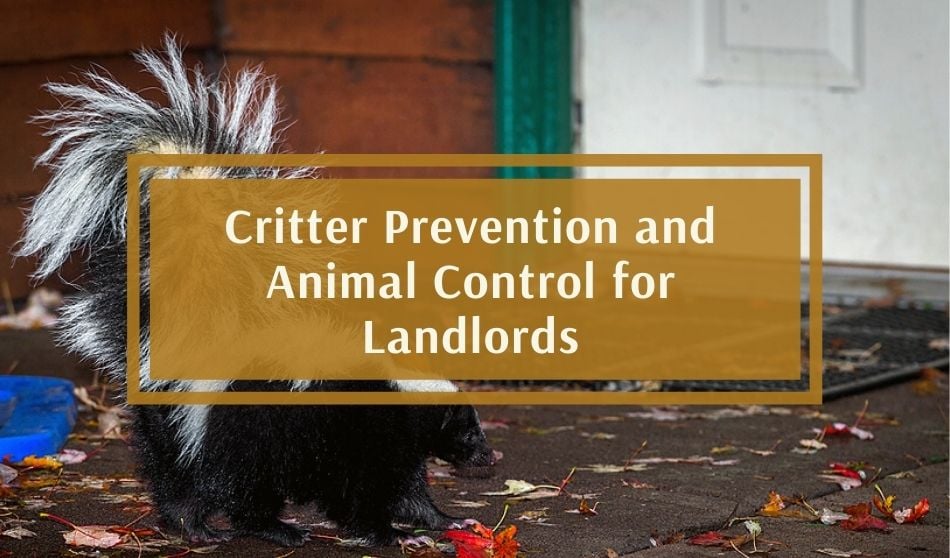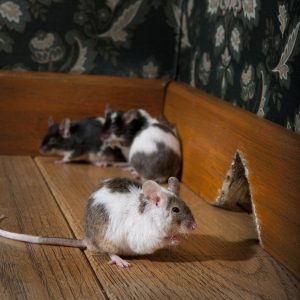
Critters, vermin, and pests visit throughout the year, seeking warmth, food, and shelter from the cold and shade and water in the warmer months. Regardless of the season, to avoid the consequences of these unwelcome guests, take these preventative steps and tactics for animal control around your property.
Animal Control Points of Concern
Damage
Vermin can chew through walls and water lines and nothing is preventing them from destroying electrical wiring. The damage to the structure would be costly to repair but the dangerous fire hazard from chewed wire could be deadly. Odor damage from trapped animals urinating or decaying in walls and flooring is problematic and burdensome to eradicate.
Loss of Revenue
Aside from the cost of repair, an unresolved issue could send a tenant packing leaving a vacancy. Tenant turnover is extremely costly, making critter prevention a smart choice. Tenants might also litigate costing much more than any preventative measure.
Landlord-Tenant Relations
Keeping on top of issues builds trust. Many people have phobias and apprehension when they encounter vermin. Providing quick and thorough animal control can calm tenant fears.
Reputation
If tenants complain to you, they are likely also complaining to neighbors, friends, family, and online. We’ve all seen scathing online reviews and blog posts that live on forever that can destroy a reputation.
Health & Safety
Pests can introduce disease and harm your residents. A good landlord knows that residents should expect the implied warranty of quiet enjoyment of their rental home in a safe and habitable condition.
How to Get Rid of Rats (and other rodents)
 Squirrels and chipmunks are climbing rodents. Gophers and prairie dogs are burrowing rodents. Rats and mice seem to be both climbing and burrowing critters. They also impact rental properties negatively much more than say a squirrel population. Prevention is key but animal control for rats and mice is paramount in the rental industry. Before calling an exterminator, try these suggestions.
Squirrels and chipmunks are climbing rodents. Gophers and prairie dogs are burrowing rodents. Rats and mice seem to be both climbing and burrowing critters. They also impact rental properties negatively much more than say a squirrel population. Prevention is key but animal control for rats and mice is paramount in the rental industry. Before calling an exterminator, try these suggestions.
- If you’ve found evidence such as mouse droppings or chew marks be sure to find and deal with their entry points as soon as possible. To find where they are traveling to and from in your home, have the tenant sprinkle baby powder or baking powder on the floor before bed. In the morning, ask them to follow the footprints.
- Caulk holes quickly. You can also try stuffing holes with steel wool as they can’t chew through it. Don’t skip over the small hole. Their heads are only six millimeters so if you can fit your pinky in the hole, they likely can fit through.
- Rodents and their droppings and urine carry disease. Their urine will also attract other rodents to the area. Clean the area quickly but carefully. Use gloves and masks, throw out contaminated food, and disinfect the area thoroughly.
- Try using peppermint oil to repel rodents.
- If there is a tree near the home in an area known for owls, installing an owl box might be a solution. Owls will nest in the box and will have a feast and help control any rodent over-population.
- The Center for Disease Control (CDC) does not recommend glue or live traps as they scare mice causing them to urinate. The urine contains germs and attracts other rodents. Instead, they recommend using snap traps using peanut butter for bait.
How to Get Rid of Stray Cats (and/or Feral Cats)
Where do both feral cats and stray cats go in the winter? Under your home, porch, or deck most likely. Sometimes under cars. They seek warmth.
- Determine if it is a stray cat or feral by looking for a collar and/or evidence of care. In a best-case scenario, it’s a stray cat with an identification collar and can easily be coaxed out and returned to owner.
- Urine from predators, such as from a coyote or fox, can repel cats from the area. But perhaps before going to that extreme try orange or lemon peel, vinegar, or wet coffee grounds first.
- Otherwise, the only other option would be to trap the cat and take the animal to the local shelter. Try to find one that has a trap-neuter-return (TNR) program to stop the breeding cycle or a tame and rehoming program.
How to Get Rid of Skunks
When it comes to these smelly vermin and animal control, the best offense is a good defense. Try these tactics when you get a tenant complaint about skunks in the area.
Close the Kitchen
Skunks are scavengers and will feed on almost anything available.
- Don’t allow tenants to have bird feeders. Seeds from bird feeders not only attract unwanted skunks who feast on fallen seeds but also attract unwanted squirrels, birds, and rodents.
- If your residents create compost gardening material, be sure to specify in the lease that any compost bin must be securely enclosed.
- Ask the tenant to harvest garden veggies, ripe fruit, nuts, berries, daily especially anything fallen to the ground.
- Consider removing the food sources (tree, bush, garden) altogether if it becomes a beacon for critters and source of tenant complaints.
Make Skunks Uncomfortable
Skunks like to hide and want to do so in a comfy location.
- Under decks and porches use rocks and fencing to make the area unappealing or inaccessible.
- Trim bushes and use uncomfortable mulch options.
- Unlike raccoons, skunks are quick to frighten. Similar to raccoons, they don’t like bright lights. Motion-sensor lights are a good idea for both critters for animal control.
- When all else fails, remove them from the premises. Removing skunks from your property can be tricky as setting a trap of some sort comes with the high probability that the skunk will spray. It may be best to call a wildlife or animal control organization for assistance.
How to Get Rid of Raccoons
As a previous property manager at a rustic resort, having a few raccoons walk among the cabins added charm to the property. But that charm goes away quickly in a rental home where raccoons can cause not only a ruckus but also potential damage to the property.
They are clever, strong, and determined. But their other superpower is adaptability which makes getting rid of raccoons difficult. Those nimble hands could wreak havoc so address ing a raccoon problem is important.
ing a raccoon problem is important.
Unfortunately, the repellents you can make or buy such as (ammonia, peppermint, capsaicin) only mask the smells that attract them and aren’t a long-term solution as these critters are hard to dissuade. A comprehensive plan is best. With one or all of these tricks, the raccoon(s) are likely to evict themselves.
Outdoors
- Secure garbage bins with a heavy or locking lid. If necessary, use a rope or bungee cord.
- Do not allow tenants to feed pets or animals outdoors.
- They will drink from any standing water so make sure to remove any drinking options from the yard such as bird feeders, planters, containers, etc.
- Raccoons are nocturnal and sensitive to light. Install motion-sensor lights around the home will annoy them and make the area unappealing.
- Install motion sensor sprinklers for a quick unexpected fright. They don’t mind rain but they do mind the unexpected.
- Repellents can be useful such as adding Epsom salts to your outdoor plants and gardens serving as both a fertilizer and raccoon deterrent. Unfortunately, it is labor-intensive to reapply and not as effective as other solutions. Take care using raccoon repellents when children or pets live in the home.
Indoors
- Locate the entry point. Raccoons are strong and are known to pull boards and siding off to gain entry.
- Try an ultrasonic device to chase them out.
- If that doesn’t work, you might flood the area with bright light.
- Some recommend raccoon repellents with a strong odor such as ammonia-soaked cloth or in a bowl.
- Then block the entrance they used with a heavy metal screen until it can be appropriately sealed.
Best Practices for Animal Control
Pests come in all sizes, shapes, and species from insects to stray cats. With all unwanted critters, the overarching principles for animal control and pest control are to employ deterrents, deploy repellents, and when all else fails resort to removal.
Deterrents
Prevention should be the number one practice to prevent an unwanted pest from getting cozy in your rental property.
- Conduct a home inspection and animal-proof the exterior. Check for entry points including crawlspaces and attic. Weatherstrip all exterior doors. Then be sure to seal, caulk, and/or cover any holes or cracks discovered.
- Landscaping and yard care can make the area uninviting and uncomfortable to pesky critters. Trim trees to keep climbing rodents from using limbs as a bridge to a roof or awning. Keep bushes pruned. Use low maintenance landscaping which tends to be less pest friendly.
- Put provisions in the lease or rental agreement as well as in your rules and regulations to prohibit feeding any animals outdoors.
Repellents
Even with all your best efforts, and even if your tenant has kept the home clean, a vermin may still be persistent. Timing is important so as soon as you’ve been made aware it’s time to aggressively drive them away. There isn’t a cookie-cutter solution but common ones involve introducing repellent odors, bright lights, water sprays, and/or electronic noise devices.
Removal
When all else fails and skunks, raccoons, rodents, or stray cats move in, it may be time to get rid of them with a proper eviction by calling in the professionals.
(Updated content: article originally published Oct 23, 2019)






Thank you for suggesting that people try to find out if the cat is a stray, or find a TNR group for feral cat issues. 😻
Thanks Rochelle! Glad you liked it, feel free to share this with your network.